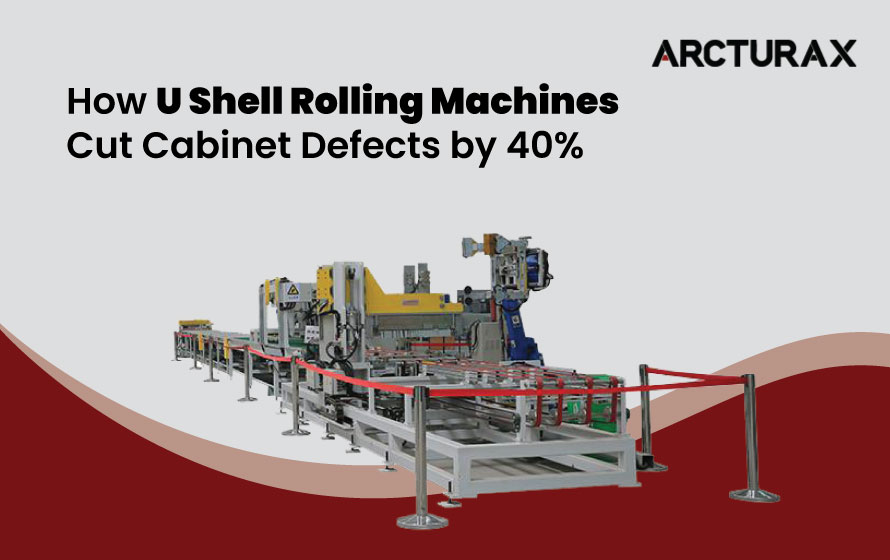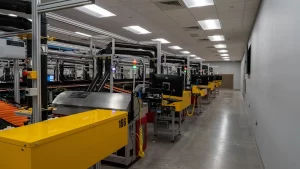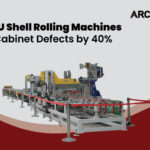In the competitive refrigerator manufacturing industry, product quality directly affects brand reputation, operational costs, and ultimately, market position. A staggering 12% defect rate has become the unfortunate industry norm for many manufacturers struggling with cabinet forming processes. However, innovative automation solutions like Arcturax’s U shell rolling and foaming machines are revolutionizing production standards by slashing defect rates by up to 40%. This dramatic improvement isn’t just a statistic-it represents millions in saved costs and significantly enhanced product reliability.
The Hidden Cost of Cabinet Defects in Refrigerator Manufacturing
Cabinet defects in refrigerator manufacturing extend far beyond simple cosmetic issues. Each misaligned bend, imprecise dimension, or inconsistent foaming application creates a cascade of problems that affect the entire production line. These defects manifest in several critical ways:
The primary challenge begins with material waste, where scrapped components due to poor forming can account for 4-5% of total production costs. When these defects go undetected until later stages, the financial impact multiplies significantly. Even more concerning, inconsistent cabinet forming leads to poor insulation performance, directly affecting the refrigerator’s energy efficiency ratings and compliance with increasingly stringent regulatory standards.
For quality control teams, these issues create an endless cycle of inspections, rework, and production delays. Many manufacturers report spending upwards of 15% of their labor hours on defect remediation alone. This drain on resources creates bottlenecks throughout the production process, extending manufacturing cycles and delaying order fulfillment.
Understanding U Shell Forming Technology
U shell components form the critical structural foundation of modern refrigerators. These components create the distinctive U-shaped profile that enables efficient assembly while maintaining structural integrity across the appliance’s lifetime. The forming process traditionally involves multiple manual interventions, creating numerous opportunities for inconsistency.
The U Shell rolling and forming machine revolutionizes this process through sophisticated automation. This comprehensive production line integrates multiple critical operations including automatic loading, precision punching, 180° overturning, rolling, Z-bending and flanging, piercing-curing and bending, adhesive application, U-shape bending, and automated unloading.
What distinguishes advanced U shell forming systems is their ability to handle various materials efficiently, including pre-painted steel plate and PCM (pre-coated metal) sheets with thicknesses ranging from 0.45mm to 0.6mm. The forming process maintains precise dimensional control throughout multiple bending operations, ensuring consistency across production runs.
How Automation Dramatically Reduces Manufacturing Defects
The transition from manual or semi-automated processes to fully automated U shell forming represents a paradigm shift in production quality. Automation addresses defect reduction through several key mechanisms:
Elimination of Human Variability
Manual operations, regardless of operator skill level, inevitably introduce variability. Each bending operation performed by hand creates minute inconsistencies that accumulate throughout the manufacturing process. Automated systems execute identical movements with micron-level precision on every cycle, maintaining consistency even across prolonged production runs.
The impact is particularly noticeable in high-precision operations like Z-bending and flanging, where even small deviations can affect final assembly fit. By removing human variability from these critical processes, automated systems eliminate a primary source of defects.
Real-Time Quality Monitoring
Modern U shell forming lines incorporate sophisticated sensor arrays that continuously monitor product dimensions, material properties, and forming parameters. This real-time assessment allows the system to detect potential issues before they become defects, adjusting parameters automatically to maintain quality specifications.
The data collected through these monitoring systems also enables continuous process improvement through statistical analysis. Manufacturers can identify subtle trends that might indicate maintenance needs or opportunities for further optimization.
Consistent Material Handling
Material handling represents another significant source of defects in traditional manufacturing. Improper positioning before bending operations or inconsistent material feed rates can create unpredictable results. Automated systems use precision positioning mechanisms to ensure exact material placement throughout the forming process.
This consistent handling proves especially important when working with pre-coated materials that require careful treatment to prevent surface damage. The automated systems minimize contact points and control pressure application precisely, preserving surface finish quality.
Arcturax’s U Shell Rolling & Foaming Solution
Arcturax has developed a comprehensive U shell rolling and foaming solution that addresses the specific challenges of refrigerator cabinet manufacturing. The system stands out through several distinctive features:
The production line achieves impressive dimensional versatility, accommodating U depths from 400mm to 650mm, heights from 450mm to 2000mm, and widths from 450mm to 700mm. This flexibility allows manufacturers to produce multiple product variations on a single line, reducing changeover times and increasing production flexibility.
Most impressively, the system achieves a cycle time of just 25 seconds per piece, enabling high-volume production while maintaining exceptional quality standards. The automated workflow eliminates production bottlenecks common in manual processes, creating smooth operational flow throughout the manufacturing facility.
The integrated foaming system ensures consistent insulation application, directly addressing one of the most common sources of energy performance issues in finished refrigerators. By precisely controlling foam density and distribution, the system contributes to improved product efficiency and regulatory compliance.
Quantifiable Benefits Beyond Defect Reduction
While the 40% defect reduction represents a headline achievement, manufacturers implementing U shell automation realize numerous additional benefits:
Energy Efficiency Improvements
The precision foaming capabilities contribute directly to refrigerator energy performance. Uniform insulation thickness and density ensure consistent thermal properties, helping manufacturers meet or exceed energy efficiency ratings. This consistency translates to improved product performance and reduced warranty claims related to energy consumption concerns.
Additionally, the automation system itself operates with greater energy efficiency than traditional methods. The optimized motion control and process integration reduce total energy consumption by approximately 25% compared to conventional manufacturing approaches.
Labor Optimization and Safety Enhancement
By automating physically demanding and repetitive tasks, U shell forming systems allow manufacturers to reallocate labor to higher-value activities. Workers transition from manual handling to system oversight, quality assurance, and continuous improvement initiatives. This shift not only improves operational efficiency but also reduces workplace injuries associated with repetitive manual tasks.
The ergonomic benefits extend beyond injury reduction, with many manufacturers reporting improved employee satisfaction and retention after implementing automated systems. The technology creates opportunities for workforce upskilling, transforming production roles into more technical positions.
Production Flexibility and Scalability
Modern U shell automation adapts quickly to changing production requirements. Programmable parameters allow rapid changeovers between different refrigerator models, supporting flexible manufacturing strategies. This adaptability proves particularly valuable as market demands shift toward greater product customization and shorter production runs.
The modular design approach enables manufacturers to scale production capacity incrementally, adding capability as market demand increases. This scalability provides a significant competitive advantage in rapidly evolving markets.
Implementation Strategy for Maximum Impact
Achieving the full 40% defect reduction potential requires a thoughtful implementation approach. Successful manufacturers typically follow a structured methodology:
First, conduct a comprehensive assessment of current manufacturing processes, identifying specific defect sources and their root causes. This analysis establishes baseline metrics for measuring improvement and prioritizing automation investments. Next, implement the U shell rolling and forming technology in phases, beginning with the most problematic areas identified in the assessment. This incremental approach minimizes disruption while demonstrating quick wins that build organizational support.
Finally, establish ongoing monitoring and continuous improvement protocols. The data-rich nature of automated systems provides unprecedented insight into manufacturing processes, creating opportunities for further optimization beyond the initial implementation.
The Competitive Imperative of Defect Reduction
In today’s manufacturing environment, cabinet defect reduction represents more than a quality improvement initiative-it’s becoming a competitive necessity. The 40% defect reduction achievable through U shell rolling automation directly impacts business performance across multiple dimensions, from operational efficiency to market reputation.
Refrigerator manufacturers face increasing pressure from both regulatory requirements and consumer expectations. Automated U shell forming technology offers a proven path to meeting these challenges while simultaneously improving profitability through reduced waste and enhanced productivity.
As industry leaders continue adopting these technologies, manufacturers still relying on traditional methods risk falling behind in both quality standards and operational efficiency. The question is no longer whether to implement U shell forming automation, but how quickly organizations can transform their manufacturing operations to realize its benefits.
Explore how U shell automation can transform your refrigerator manufacturing process? Contact Arcturax today for a customized assessment of your operation and discover your specific defect reduction potential.



